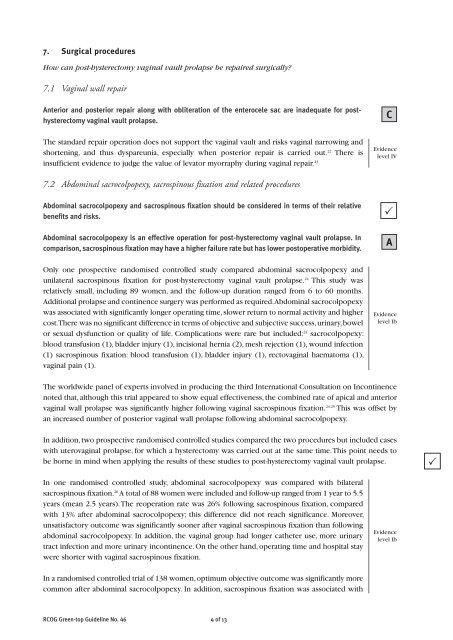The Management of Post Hysterectomy Vaginal Vault Prolapse ...
The Management of Post Hysterectomy Vaginal Vault Prolapse ...
The Management of Post Hysterectomy Vaginal Vault Prolapse ...
Create successful ePaper yourself
Turn your PDF publications into a flip-book with our unique Google optimized e-Paper software.
7. Surgical proceduresHow can post-hysterectomy vaginal vault prolapse be repaired surgically?7.1 <strong>Vaginal</strong> wall repairAnterior and posterior repair along with obliteration <strong>of</strong> the enterocele sac are inadequate for posthysterectomyvaginal vault prolapse.<strong>The</strong> standard repair operation does not support the vaginal vault and risks vaginal narrowing andshortening, and thus dyspareunia, especially when posterior repair is carried out. 22 <strong>The</strong>re isinsufficient evidence to judge the value <strong>of</strong> levator myorraphy during vaginal repair. 23CEvidencelevel IV7.2 Abdominal sacrocolpopexy, sacrospinous fixation and related proceduresAbdominal sacrocolpopexy and sacrospinous fixation should be considered in terms <strong>of</strong> their relativebenefits and risks.̌Abdominal sacrocolpopexy is an effective operation for post-hysterectomy vaginal vault prolapse. Incomparison, sacrospinous fixation may have a higher failure rate but has lower postoperative morbidity.Only one prospective randomised controlled study compared abdominal sacrocolpopexy andunilateral sacrospinous fixation for post-hysterectomy vaginal vault prolapse. 24 This study wasrelatively small, including 89 women, and the follow-up duration ranged from 6 to 60 months.Additional prolapse and continence surgery was performed as required.Abdominal sacrocolpopexywas associated with significantly longer operating time, slower return to normal activity and highercost. <strong>The</strong>re was no significant difference in terms <strong>of</strong> objective and subjective success, urinary, bowelor sexual dysfunction or quality <strong>of</strong> life. Complications were rare but included: 24 sacrocolpopexy:blood transfusion (1), bladder injury (1), incisional hernia (2), mesh rejection (1), wound infection(1) sacrospinous fixation: blood transfusion (1), bladder injury (1), rectovaginal haematoma (1),vaginal pain (1).AEvidencelevel Ib<strong>The</strong> worldwide panel <strong>of</strong> experts involved in producing the third International Consultation on Incontinencenoted that, although this trial appeared to show equal effectiveness, the combined rate <strong>of</strong> apical and anteriorvaginal wall prolapse was significantly higher following vaginal sacrospinous fixation. 24,25 This was <strong>of</strong>fset byan increased number <strong>of</strong> posterior vaginal wall prolapse following abdominal sacrocolpopexy.In addition, two prospective randomised controlled studies compared the two procedures but included caseswith uterovaginal prolapse, for which a hysterectomy was carried out at the same time. This point needs tobe borne in mind when applying the results <strong>of</strong> these studies to post-hysterectomy vaginal vault prolapse.̌In one randomised controlled study, abdominal sacrocolpopexy was compared with bilateralsacrospinous fixation. 26 A total <strong>of</strong> 88 women were included and follow-up ranged from 1 year to 5.5years (mean 2.5 years). <strong>The</strong> reoperation rate was 26% following sacrospinous fixation, comparedwith 13% after abdominal sacrocolpopexy; this difference did not reach significance. Moreover,unsatisfactory outcome was significantly sooner after vaginal sacrospinous fixation than followingabdominal sacrocolpopexy. In addition, the vaginal group had longer catheter use, more urinarytract infection and more urinary incontinence. On the other hand, operating time and hospital staywere shorter with vaginal sacrospinous fixation.Evidencelevel IbIn a randomised controlled trial <strong>of</strong> 138 women, optimum objective outcome was significantly morecommon after abdominal sacrocolpopexy. In addition, sacrospinous fixation was associated withRCOG Green-top Guideline No. 464 <strong>of</strong> 13
















